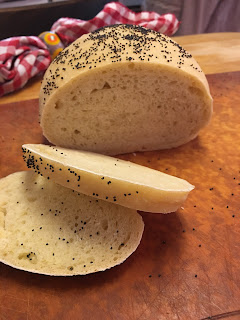
Back in March, I started to revisit my year of weekly Slovenian dinners. I have now reached the halfway point. Many of those dishes from 2012 were familiar, since they had become favorites over the past decade. Others had fallen by the wayside, so it was a chance to rediscover them.
Sometimes the most rewarding recipes were the ones that didn't quite work the first time. This bread recipe was one of them, probably because it had to meet an impossibly high standard: my memories of my grandmother's bread. I was determined to recreate it. She served it every time we visited, when it was still warm from the oven.
I remembered a high-rising homestyle loaf with a texture that was light and tender, but also hearty. My brother (also a baker) describes a somewhat coarse crumb. My husband wonders if it was cake-like. My grandmother never used recipes. I have no idea how she worked her magic. But I figured there might be a hint in my collection of vintage Slovenian American cookbooks.
The Progressive Slovene Women of America caught my eye with a recipe they called by two names: white bread or beli kruh (which I initially misunderstood as a reference to the bread's beauty rather than its color!).The ingredients were ordinary enough, but the method was more elaborate than similar recipes, because it called for an initial sponge and then three more risings.
The first time I made this recipe, the bread looked beautiful (see below) and the flavor and texture were pretty good. But it was nothing out of the ordinary. Not worth the extra time and effort. So I went on to try other recipes. Potato bread, after my mother recalled that her mother might have used potato water. A special braided bread similar to challah that was lovely, but not like my grandma's delectable everyday bread.
And then my 2022 Anniversary Update brought me back to the original bread recipe I had tried. And I saw the problem. I had used bread flour, which absorbs more liquid, rather than the standard all purpose flour that mid-century bakers would have used. And I had compounded the problem by either ignoring or misunderstanding the implications of "6 cups sifted flour." By measuring before (or without) sifting, I would have ended up with 20-30 percent more flour than the recipe called for. No wonder I had trouble kneading it all in!
So made the necessary adjustments and tried to make the bread again, following the recipe closely. And then I made it one more time, just to be sure I had it right.
Prepared correctly, this recipe turned into a winner! It is very close to the bread I remember savoring in my grandparents' small bungalow in Cleveland, all those decades ago. In the recipe that follows, you do not have to sift the flour. But I have tried it both ways, and I think sifting may improve the texture. So why not try it the old-fashioned way, at least once?
White Bread or Beli Kruh (adapted from The Progressive Slovene Women of America)
1 tablespoon yeast
1 cup lukewarm water
113 g all purpose flour (= 1 cup sifted or about 3/4 cup unsifted)
1 egg, beaten
2 tablespoons sugar
678 g all purpose flour (= 6 cups sifted or about 4.5 cups unsifted)
2 teaspoons salt
1 tablespoon melted butter
1 cup lukewarm water
First make the sponge: Combine the first five ingredients. Let rise in a warm place until doubled in size.



No comments:
Post a Comment